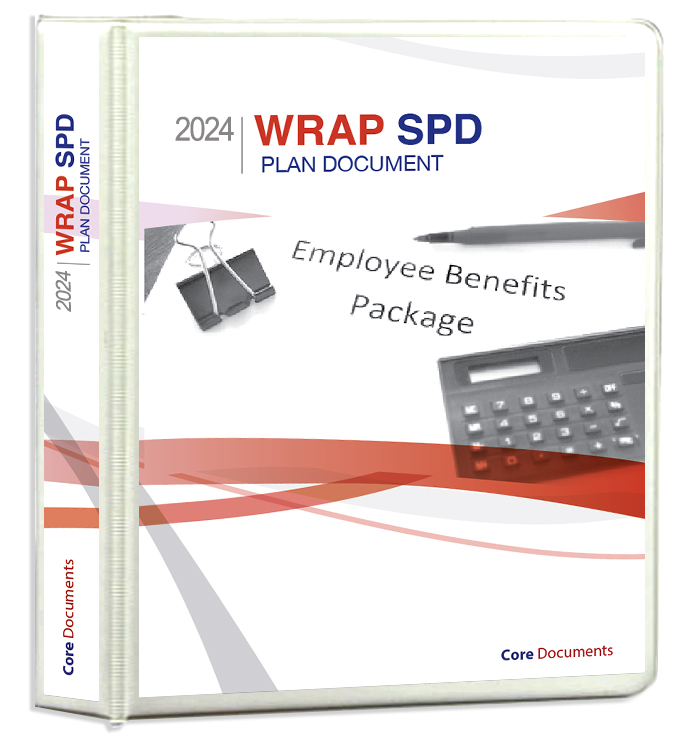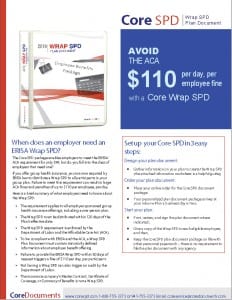Home / Blog / What the ERISA Wrap SPD must communicate to employees
What the ERISA Wrap SPD must communicate to employees
All companies with an employer-sponsored group health plan must prepare an ERISA Wrap SPD to go with their Certificate of Insurance. What follows is a summary of what the ERISA Wrap SPD must communicate to employees in plain language the employees can understand.
ERISA Wrap SPD Document Requirements
Group insurance Certificates of Insurance are typically not SPDs because they do not contain all of the language required by ERISA. An employer must prepare an ERISA “wrapper” to supplement the Certificate of Insurance. Together, the wrapper and Certificate of Insurance comprise a proper SPD.

An ERISA Wrap SPD must contain all of the following information:
- The plan name
- The plan sponsor/employer’s name and address
- The plan sponsor’s EIN
- The plan administrator’s name, address, and phone number
- Designation of any named fiduciaries, if other than the plan administrator, e.g., claim fiduciary
- The plan number for ERISA Form 5500 purposes, e.g., 501, 502, 503, etc. (Note—each ERISA plan should be assigned a unique number.)
- Type of plan or brief description of benefits, e.g., life, medical, dental, disability
- The date of the end of the plan year for maintaining the plan’s fiscal records (which may be different from the insurance policy year)
- Each trustee’s name, title, and address of principal place of business, if the plan has a trust
- The name and address of the plan’s agent for service of legal process, along with a statement that service may be made on a plan trustee or administrator
- The type of plan administration, e.g., administered by contract, insurer, or sponsor
- Eligibility terms, e.g., classes of eligible employees, employment waiting period, and hours per week, and the effective date of participation, e.g., next day or first of the month following satisfaction of an eligibility waiting period
- How the insurer refunds (e.g., dividends, demutualization, and medical loss ratio (MLR) refunds) are allocated to participants. Note: This is important for obtaining the small plan (<100 participants) exception for filing Form 5500.
- The plan sponsor’s amendment and termination rights and procedures, and what happens to plan assets, if any, in the event of plan termination
- A summary of any plan provisions governing the benefits, rights, and obligations of participants under the plan on termination or amendment of the plan or elimination of benefits
- A summary of any plan provisions governing the allocation and disposition of assets upon plan termination
- Claims procedures—may be furnished separately in a Certificate of Coverage, provided that the SPD explains that claims procedures are furnished automatically, without charge, in the separate document (e.g., a Certificate of Coverage), and time limits for lawsuits, if the plan imposes them
- A statement clearly identifying circumstances that may result in loss or denial of benefits (e.g., subrogation, coordination of benefits, and offset provisions)
- The standard of review for benefit decisions (We recommend consideration of granting full discretion for the plan administrator or authorized fiduciary to interpret the plan and make factual determinations.)
- ERISA model statement of participants’ rights
- The sources of plan contributions, whether from employer and/or employee contributions, and the method by which they are calculated
- Interim SMMs since the SPD was adopted or last restated
- The fact that the employer is a participating employer or a member of a controlled group
- Whether the plan is maintained pursuant to one or more collective bargaining agreements, and that a copy of the agreement may be obtained upon request
- A prominent offer of assistance in a non-English language (depending on the number of participants who are literate in the same non-English language)
- Identity of the insurer(s), if any
- Additional requirements for Group Health Plan SPDs:
- Detailed description of plan provisions and exclusions (e.g., copays, deductibles, coinsurance, eligible expenses, network provider provisions, prior authorization and utilization review requirements, dollar limits, day limits, visit limits, and the extent to which new drugs, preventive care, and medical tests and devices are covered) A link to network providers should also be provided. Plan limits, exceptions, and restrictions must be conspicuous.
- Information regarding COBRA, HIPAA, and other federal mandates such as the Women’s Health Cancer Rights Act, preexisting condition exclusion, special enrollment rules, mental health parity, coverage for adopted children, Qualified Medical Support Orders, and minimum hospital stays following childbirth.
- Name and address of health insurer(s), if any
- Description of the role of health insurers (i.e., whether the plan is insured by an insurance company or the insurance company is merely providing administrative services)
Recommended, but not required provisions in an ERISA Wrap SPD:
- For insured arrangements, attach the Summary of Benefits provided by the insurance companies to help ensure you have provided an understandable summary of the Certificate of Coverage
- For self-insured arrangements, provide the name, address, and phone number of any Third Party Administrator (TPA) paying claims or benefits.
- Language that in the event there is a conflict between the plan document, the SPD, and a Certificate of Insurance, which document controls
Health Care Reform – Notices/Disclosures (additional information)
Summary – The health care reform law makes many changes to health coverage requirements, such as extending coverage for young adults up to age 26, prohibiting rescissions of health coverage (except in cases of fraud or intentional misrepresentation), eliminating preexisting condition exclusions for children under the age of 19 (applicable to adults in 2014), prohibiting lifetime limits on essential health benefits and restricting annual limits, and requiring coverage for preventive care without cost sharing. The law has staggered effective dates. Many of its changes are effective now, and others will become effective in future years.
Notices/Disclosure – The health care reform law created a number of notice and disclosure obligations for group health plans, such as:
Statement of Grandfathered Status – Plan administrator or issuer was required to provide the first statement before the first plan year beginning on or after Sept. 23, 2010. The statement must continue to be provided on a periodic basis with participant materials describing plan benefits. This requirement only applies to grandfathered plans.
Notice of Patient Protections and Selection of Providers – Plan administrator or issuer must provide a notice of patient protections/selection of providers whenever the summary plan description (SPD) or similar description of benefits is provided to a participant. These provisions relate to the choice of a health care professional and benefits for emergency services. The first notice should have been provided no later than the first day of the plan year beginning on or after Sept. 23, 2010. This requirement does not apply to grandfathered plans.
Documenting method for Identifying Full-time Employees
Beginning in 2015, the Affordable Care Act (ACA) imposes a penalty on applicable large employers (ALEs) that do not offer health insurance coverage to substantially all full-time employees and dependents. An ALE may also be subject to a penalty if it offers health insurance coverage to full-time employees and dependents, but the coverage is unaffordable or does not provide minimum value. An ALE is only liable for a penalty if one or more of its full-time employees receives a health insurance subsidy for coverage under an Exchange.
The ACA’s employer penalty rules are often referred to as “employer shared responsibility” or “pay or play” rules. The pay or play rules will take effect for many ALEs on Jan. 1, 2015.
This Legislative Brief includes a brief overview of the two methods for identifying full-time employees, and it provides guidelines for documenting the method an employer decides to use. It also includes sample language for describing the look-back measurement method. This sample language, which requires customization, could be incorporated into an employer policy, health plan document or summary plan description (SPD).
Methods for identifying Full-time Employees
On Feb. 12, 2014, the Internal Revenue Service (IRS) published final regulations on the employer shared responsibility rules. The final regulations provide two methods for identifying full-time employees for purposes of offering health plan coverage and avoiding a pay or play penalty—the monthly measurement method and the look-back measurement method.
A full-time employee is an employee who was employed, on average, at least 30 hours of service per week. The final regulations treat 130 hours of service in a calendar month as the monthly equivalent of 30 hours per service per week.
Monthly Measurement Method
The monthly measurement method involves a month-to-month analysis where full-time employees are identified based on their hours of service for each calendar month. This method is not based on averaging hours of service over a prior measurement period. Month-to-month measuring may cause practical difficulties for employers, particularly if there are employees with varying hours or employment schedules, and it could result in employees moving in and out of health plan coverage on a monthly basis.
Look-back Measurement Method
To give employers flexible and workable options and greater predictability for determining full-time employee status, the IRS developed an optional look-back measurement method as an alternative to the monthly measurement method.
Under the look-back measurement method, an employer counts an employee’s hours of service during one period (called a measurement period) to determine his or her full-time status for a future period (called the stability period). The details of this method are complex, and vary based on whether the employees are ongoing or new and whether new employees are expected to work full time or are variable, seasonal or part-time employees.

The $149 ERISA Wrap SPD from Core Documents:
A simple and reliable way to meet ERISA, ACA, and DOL mandates
$149 one-time fee in PDF via email*
$199 one-time fee in PDF email* + Deluxe Binder via USPS
Don’t be intimidated by the list of requirements you just read — Core Documents provides employers with everything they need for a group health plan Wrap SPD in one affordable and convenient package.
Plus, it’s is easy to self-administer for any number of employees, and our one-time fee saves employers a lot of money.
Click to Order

Or, click here for a fillable PDF order form
No annual fee — Core Documents does not require an annual renewal fee to maintain your plan document package. By law, an ERISA Wrap SPD only needs to be updated every five years, or when there are changes in the group health plan or law that make it necessary. We will notify you when it is time for a five-year update (or changes in the Code) and ask that you keep us informed when there is a change to your group health plan.
Fast Service — Most orders placed by 3 PM are returned via email the same day, Monday through Friday. Weekend orders are sent out Monday morning. Plan document packages are processed in the order received. During our busiest months (December, January, and February), the rush order fee (see order form) marks your document to be processed immediately.
Refund Policy: Goods and services provided by Core Documents, Inc. are non-refundable upon receipt. Orders cancelled prior to shipping are subject to a fee to cover the cost of goods and services provided during the review, draft, and preparation of your order.
The Trusted Source of Affordable Benefit Plan Documents for over 20 Years.
Core Documents is the country’s leading provider of cost-effective, tax-saving benefit plan documents for Section 125 Cafeteria plans and Health Reimbursement Arrangements. The Trusted Source since 1997, thousands of satisfied agents and employer groups nationwide rely upon Core Documents for free plan design consulting services, plan document updates, ERISA Wrap SPDs, and administration services.
Video: Executive Summary of the Wrap SPD Plan Requirement
3:00 minutes
